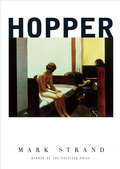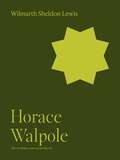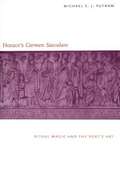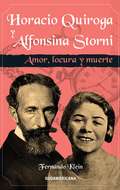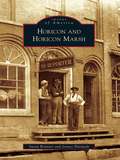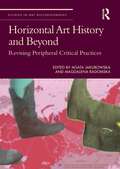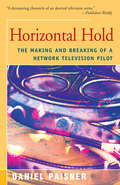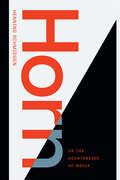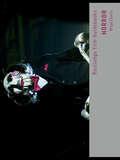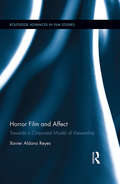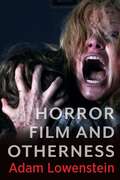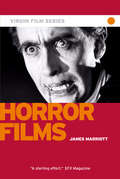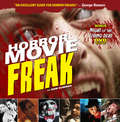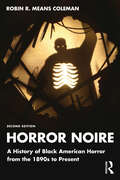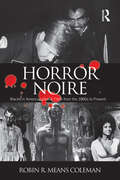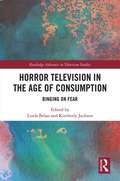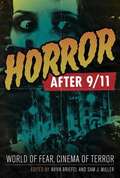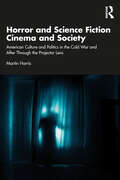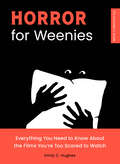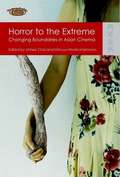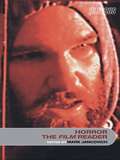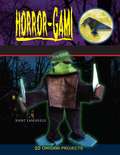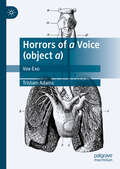- Table View
- List View
Hopper: Writers on Art
by Mark StrandNow in rich color, thirty of American painter Edward Hopper's masterpieces with critiques from acclaimed poet Mark Strand. Strand deftly illuminates the work of the frequently misunderstood American painter, whose enigmatic paintings--of gas stations, storefronts, cafeterias, and hotel rooms--number among the most powerful of our time. In brief but wonderfully compelling comments accompanying each painting, the elegant expressiveness of Strand's language is put to the service of Hopper's visual world. The result is a singularly illuminating presentation of the work of one of America's best-known artists. Strand shows us how the formal elements of the paintings--geometrical shapes pointing beyond the canvas, light from unseen sources--locate the viewer, as he says, "in a virtual space where the influence and availability of feeling predominate." An unforgettable combination of prose and painting in their highest forms, this book is a must for poetry and art lovers alike.
Horace Walpole (The A. W. Mellon Lectures in the Fine Arts #9)
by Wilmarth Sheldon LewisAn illuminating biographical study of the eighteenth-century English man of letters and patron of the artsHorace Walpole (1717–1797) was a collector, printer, novelist, arbiter of taste, and renowned writer of letters. In this book, eminent scholar Wilmarth Sheldon Lewis provides an unprecedented look at the life and work of one of England’s greatest men of letters. Lewis sheds light on Walpole’s relationships with his family and friends, his politics, his writings and printmaking activities, and his correspondence. Featuring portraits of Walpole, his relatives, and friends; images of Walpole's sketches and manuscripts; pages from books printed at Walpole’s Strawberry Hill Press; and views and plans of Strawberry Hill, the house, its rooms and furnishings, and its grounds, and accompanied by Lewis’s extensive annotations, this book provides an invaluable history of an extraordinary man.
Horace's Carmen Saeculare: Ritual Magic and the Poet's Art
by Michael C. J. Putnam"This is the first book devoted to Horace's Carmen Saeculare, a poem commissioned by Roman emperor Augustus in 17 B. C. E. for choral performance at the Ludi Saeculares, the Secular Games. The poem is the first fully preserved Latin hymn whose circumstances of presentation are known, and it is the only lyric by Horace that we can be certain was first presented orally. Michael C. J. Putnam offers a close and sensitive reading of this hymn shedding new light on the richness and virtuosity of its poetry, on the many sources Horace drew on, and on the poem's power and significance as a public ritual.
Horacio Quiroga y Alfonsina Storni: Amor, locura y muerte
by Fernando KleinUna investigación histórica con el pulso de novela que revela un amor –hasta ahora poco conocido– entre Horacio Quiroga y Alfonsina Storni. Con rigor histórico y pluma de novelista Fernando Klein nos pinta Montevideo, Buenos Aires, la selva misionera, personajes, y un amor en un tiempo fermental en ambas orillas del Plata. Alfonsina Storni una mujer de apariencia frágil de carácter fuerte y resuelto, inteligencia y fuerza de mujer viva, enamorada de la vida y de la muerte, y sobre todo de la libertad, con una pluma que enfrentó a una sociedad hipócrita y Horacio Quiroga un hombre marcado por la genialidad y la tragedia con mil vidas: dandy, naturalista, motor intelectual de una generación, excelso escritor, apasionado de la vida, coinciden en un camino marcado por la pasión carnal e intelectual. En 1916 –bajo la sombra de la Gran Guerra que atormentaba el mundo, en un Buenos Aires y Montevideo con el encendido de sus primeras luces que brillarán en las siguientes décadas– Horacio y Alfonsina construirán una historia de amor que será un remanso para los fantasmas de la locura y la depresión que sobrevuela esos corazones y mentes. Horacio Quiroga y Alfonsina Storni. Amor, locura y muerte es una reconstrucción histórica y documentada, pero también una novela donde Fernando Klein suelta la pluma y nos dibuja un paisaje bucólico lleno amor, locura y muerte. A través de estas páginas el lector podrá adentrarse en una época, un tiempo, la literatura y una sociedad a través de los ojos y corazones de dos referentes de la cultura rioplatense.
Horicon and Horicon Marsh (Images of America)
by Susan Brunner Jennee HarmuthThe city of Horicon has grown beyond its mill town roots to become home to John Deere, Gardner Manufacturing, and many community events. Meanwhile, Horicon Marsh has loomed to the north with its own story to tell. Over the years, what was once the land of the Winnebagos has been flooded, drained, dredged, and farmed. However, thanks to a restoration movement that began in the 1920s, Horicon Marsh stands today as the largest freshwater cattail marsh in the United States.
Horizontal Art History and Beyond: Revising Peripheral Critical Practices (Studies in Art Historiography)
by Agata JakubowskaThis book is devoted to the concept of horizontal art history—a proposal of a paradigm shift formulated by the Polish art historian Piotr Piotrowski (1952–2015)—that aims at undermining the hegemony of the discourse of art history created in the Western world. The concept of horizontal art history is one of many ideas on how to conduct nonhierarchical art historical analysis that have been developed in different geopolitical locations since at least the 1970s, parallel to the ongoing process of decolonization. This book is a critical examination of horizontal art history which provokes a discussion on the original concept of horizontal art history and possible methods to extend it. This is an edited volume written by international scholars who acknowledge the importance of the concept, share its basic assumptions and are aware both of its advantages and limitations. The book will be of interest to scholars working in art history, art historiography and postcolonial studies.
Horizontal Hold: The Making and Breaking of a Network Television Pilot
by Daniel PaisnerAbsurdly funny, trenchant, and provocative, this outside-looking-in account of the stillbirth of one particular television series is a must read for every serious and not-so-serious television viewer.
Horn, or The Counterside of Media (Sign, Storage, Transmission)
by Henning SchmidgenWe regularly touch and handle media devices. At the same time, media devices such as body scanners, car seat pressure sensors, and smart phones scan and touch us. In Horn, Henning Schmidgen reflects on the bidirectional nature of touch and the ways in which surfaces constitute sites of mediation between interior and exterior. Schmidgen uses the concept of "horn"—whether manifested as a rhinoceros horn or a musical instrument—to stand for both natural substances and artificial objects as spaces of tactility. He enters into creative dialogue with artists, scientists, and philosophers, ranging from Salvador Dalí, William Kentridge, and Rebecca Horn to Sigmund Freud, Walter Benjamin, and Marshall McLuhan, who plumb the complex interplay between tactility and technological and biological surfaces. Whether analyzing how Dalí conceived of images as tactile entities during his “rhinoceros phase” or examining the problem of tactility in Thomas Pynchon’s The Crying of Lot 49, Schmidgen reconfigures understandings of the dynamic phenomena of touch in media.
Horrible Harry and the Scarlet Scissors (Horrible Harry #32)
by Suzy Kline Amy WummerWill the best artist win? The art teacher asks the students of Room 3B to draw posters of things they love, and one of them will get to display his or her artwork on South School's brand-new TV show. Harry doesn't care about the contest. Mary, on the other hand, is convinced that her poster is the best, and she can't wait for her television debut. But if Mary's poster doesn't get selected, then she's going to make horrible trouble for Room 3B--especially Harry!
Horror (Routledge Film Guidebooks)
by Brigid CherryHorror cinema is a hugely successful, but at the same time culturally illicit genre that spans the history of cinema. It continues to flourish with recent cycles of supernatural horror and torture porn that span the full range of horror styles and aesthetics. It is enjoyed by audiences everywhere, but also seen as a malign influence by others. In this Routledge Film Guidebook, audience researcher and film scholar Brigid Cherry provides a comprehensive overview of the horror film and explores how the genre works. Examining the way horror films create images of gore and the uncanny through film technology and effects, Cherry provides an account of the way cinematic and stylistic devices create responses of terror and disgust in the viewer. Horror examines the way these films construct psychological and cognitive responses and how they speak to audiences on an intimate personal level, addressing their innermost fears and desires. Cherry further explores the role of horror cinema in society and culture, looking at how it represents various identity groups and engages with social anxieties, and examining the way horror sees, and is seen by, society.
Horror Film and Affect: Towards a Corporeal Model of Viewership (Routledge Advances in Film Studies)
by Xavier Aldana ReyesThis book brings together various theoretical approaches to Horror that have received consistent academic attention since the 1990s – abjection, disgust, cognition, phenomenology, pain studies – to make a significant contribution to the study of fictional moving images of mutilation and the ways in which human bodies are affected by those on the screen on three levels: representationally, emotionally and somatically. Aldana Reyes reads Horror viewership as eminently carnal, and seeks to articulate the need for an alternative model that understands the experience of feeling under corporeal threat as the genre’s main descriptor. Using recent, post-millennial examples throughout, the book also offers case studies of key films such as Hostel, [REC], Martyrs or Ginger Snaps, and considers contemporary Horror strands such as found footage or 3D Horror.
Horror Film and Otherness (Film and Culture Series)
by Adam LowensteinWhat do horror films reveal about social difference in the everyday world? Criticism of the genre often relies on a dichotomy between monstrosity and normality, in which unearthly creatures and deranged killers are metaphors for society’s fear of the “others” that threaten the “normal.” The monstrous other might represent women, Jews, or Blacks, as well as Indigenous, queer, poor, elderly, or disabled people. The horror film’s depiction of such minorities can be sympathetic to their exclusion or complicit in their oppression, but ultimately, these images are understood to stand in for the others that the majority dreads and marginalizes.Adam Lowenstein offers a new account of horror and why it matters for understanding social otherness. He argues that horror films reveal how the category of the other is not fixed. Instead, the genre captures ongoing metamorphoses across “normal” self and “monstrous” other. This “transformative otherness” confronts viewers with the other’s experience—and challenges us to recognize that we are all vulnerable to becoming or being seen as the other. Instead of settling into comforting certainties regarding monstrosity and normality, horror exposes the ongoing struggle to acknowledge self and other as fundamentally intertwined.Horror Film and Otherness features new interpretations of landmark films by directors including Tobe Hooper, George A. Romero, John Carpenter, David Cronenberg, Stephanie Rothman, Jennifer Kent, Marina de Van, and Jordan Peele. Through close analysis of their engagement with different forms of otherness, this book provides new perspectives on horror’s significance for culture, politics, and art.
Horror Films - Virgin Film
by James MarriottFrom the Slick horror of Alien, Scream and The Ring and the cult classics Dracula, Frankenstein and The Mummy to the slasher icons Jason, Freddy and Leatherface, horror just won’t stay dead. The genre has earned its place in the moviegoing psyche, with many of the key films spawning numerous copycats. But what are the 20 most influential horror films of all time? And what made them so important?James Marriott give an incisive account of the definitive works (and the most influential directors) of the genre over the last 80 years – from silent Expressionist classics to Japanese wraiths. The book reveals the inspiration behind each film and examines the choice of director, cast, soundtrack and marketing. Marriott analyzes the critical reception of each film and examines the subsequent impact on the industry and the public worldwide.
Horror Movie Freak
by Don SumnerYou'll scream with delight while reading this fun and engaging book that discusses fright flicks all horror fans need to see to ascend to the level of a true Horror Freak -from classics (Dracula and Psycho) to modern movies (Drag Me to Hell) and lesser-known gems (Dog Soldiers). Movies are divided into various categories including Asian horror, beginners, homicidal slashers, supernatural thrillers, and zombie invasion. Features more than 130 movies, 250+ photos of movie stills and posters, and a chapter on remakes and reimaginings. The book also includes the DVD of George A. Romero's original 1968 version of "Night of the Living Dead."
Horror Noire: A History of Black American Horror from the 1890s to Present
by Robin R. Means ColemanFrom King Kong to Candyman, the boundary-pushing genre of horror film has always been a site for provocative explorations of race in American popular culture. This book offers a comprehensive chronological survey of Black horror from the 1890s to present day. In this second edition, Robin R. Means Coleman expands upon the history of notable characterizations of Blackness in horror cinema, with new chapters spanning the 1960s, 2000s, and 2010s to the present, and examines key levels of Black participation on screen and behind the camera. The book addresses a full range of Black horror films, including mainstream Hollywood fare, art-house films, Blaxploitation films, and U.S. hip-hop culture-inspired Nollywood films. This new edition also explores the resurgence of the Black horror genre in the last decade, examining the success of Jordan Peele’s films Get Out (2017) and Us (2019), smaller independent films such as The House Invictus (2018), and Nia DaCosta’s sequel to Candyman (2021). Means Coleman argues that horror offers a unique representational space for Black people to challenge negative or racist portrayals, and to portray greater diversity within the concept of Blackness itself. This book is essential reading for anyone seeking to understand how fears and anxieties about race and race relations are made manifest, and often challenged, on the silver screen.
Horror Noire: Blacks in American Horror Films from the 1890s to Present
by Robin R Means ColemanFrom King Kong to Candyman, the boundary-pushing genre of the horror film has always been a site for provocative explorations of race in American popular culture. In Horror Noire: Blacks in American Horror Films from 1890's to Present, Robin R. Means Coleman traces the history of notable characterizations of blackness in horror cinema, and examines key levels of black participation on screen and behind the camera. She argues that horror offers a representational space for black people to challenge the more negative, or racist, images seen in other media outlets, and to portray greater diversity within the concept of blackness itself. Horror Noire presents a unique social history of blacks in America through changing images in horror films. Throughout the text, the reader is encouraged to unpack the genre’s racialized imagery, as well as the narratives that make up popular culture’s commentary on race. Offering a comprehensive chronological survey of the genre, this book addresses a full range of black horror films, including mainstream Hollywood fare, as well as art-house films, Blaxploitation films, direct-to-DVD films, and the emerging U.S./hip-hop culture-inspired Nigerian "Nollywood" Black horror films. Horror Noire is, thus, essential reading for anyone seeking to understand how fears and anxieties about race and race relations are made manifest, and often challenged, on the silver screen.
Horror Television in the Age of Consumption: Binging on Fear (Routledge Advances in Television Studies)
by Kimberly Jackson Linda BelauCharacterized as it is by its interest in and engagement with the supernatural, psycho-social formations, the gothic, and issues of identity and subjectivity, horror has long functioned as an allegorical device for interrogations into the seamier side of cultural foundations. This collection, therefore, explores both the cultural landscape of this recent phenomenon and the reasons for these television series’ wide appeal, focusing on televisual aesthetics, technological novelties, the role of adaptation and seriality, questions of gender, identity and subjectivity, and the ways in which the shows’ themes comment on the culture that consumes them. Featuring new work by many of the field’s leading scholars, this collection offers innovative readings and rigorous theoretical analyses of some of our most significant contemporary texts in the genre of Horror Television.
Horror after 9/11
by Aviva Briefel Sam J. MillerHorror films have exploded in popularity since the tragic events of September 11, 2001, many of them breaking box-office records and generating broad public discourse. These films have attracted A-list talent and earned award nods, while at the same time becoming darker, more disturbing, and increasingly apocalyptic. Why has horror suddenly become more popular, and what does this say about us? What do specific horror films and trends convey about American society in the wake of events so horrific that many pundits initially predicted the death of the genre? How could American audiences, after tasting real horror, want to consume images of violence on screen? Horror after 9/11 represents the first major exploration of the horror genre through the lens of 9/11 and the subsequent transformation of American and global society. Films discussed include the Twilight saga; the Saw series; Hostel; Cloverfield; 28 Days Later; remakes of The Texas Chainsaw Massacre, Dawn of the Dead, and The Hills Have Eyes; and many more. The contributors analyze recent trends in the horror genre, including the rise of ‘torture porn,’ the big-budget remakes of classic horror films, the reinvention of traditional monsters such as vampires and zombies, and a new awareness of visual technologies as sites of horror in themselves. The essays examine the allegorical role that the horror film has held in the last ten years, and the ways that it has been translating and reinterpreting the discourses and images of terror into its own cinematic language.
Horror and Science Fiction Cinema and Society: American Culture and Politics in the Cold War and After Through the Projector Lens
by Martin HarrisExamining how horror and science fiction films from the 1950s to the present invent and explore fictional “us-versus-them” scenarios, this book analyzes the different ways such films employ allegory and/or satire to interrogate the causes and consequences of increasing polarization in American politics and society.Starting with the killer ants film with an anti-communist subtext Them! (1954) and concluding with Jordan Peele’s social horror film with revenge-seeking homicidal doppelgängers Us (2019), Martin Harris highlights social and political contexts, contemporary reviews and responses, and retrospective evaluations to show how American horror and science fiction films reflect and respond to contemporary conflicts marking various periods in U.S. history from post-WWII to the present, including those concerning race, gender, class, faith, political ideology, national identity, and other elements of American society.Horror and Science Fiction Cinema and Society draws upon cinematic sociology to provide a resourceful approach to American horror and science fiction films that integrates discussion of plot construction and character development with analyses of the thematic uses of conflict, guiding readers’ understanding of how filmmakers create otherworldly confrontations to deliver real-world social and political commentary.
Horror for Weenies: Everything You Need to Know About the Films You're Too Scared to Watch
by Emily C. HughesA smart, funny crash course in 25 iconic horror movies, from Psycho to Hereditary, for people who love getting the reference but hate being scared.You don't have to miss out just because you don't like to be frightened! Stop trying to read nonsensical Wikipedia plot summaries (we know you&’re doing it), and let an expert tell you everything you need to know about the most influential horror films of the past 60 years—without a single jump scare or a drop of gore.With a rundown of the history and significance of horror cinema, explanations of common tropes, and detailed entries on 25 important movies ranging from Night of the Living Dead to The Blair Witch Project to Get Out, Horror for Weenies will turn even the scarediest of cats into a confident connoisseur.Each entry includes: A detailed plot summary, with enough jokes that it won&’t freak you outSmart, illuminating analysis of the film&’s themes and cultural significance Descriptions of iconic scenes you definitely do not want to look at Talking points for impressing even the biggest scary-movie buffsHorror for Weenies is the first installment in the Outsider&’s Guide series, which offers highly readable crash courses in major cultural phenomena, so you can catch the references and understand the big deal. Never get left out of a conversation again!
Horror in Architecture: The Reanimated Edition
by Joshua Comaroff Ong Ker-ShingA new edition of this extensive visual analysis of horror tropes and their architectural analogues Horror in Architecture presents an unflinching look at how horror genre tropes manifest in the built environment. Spanning the realms of art, design, literature, and film, this newly revised and expanded edition compiles examples from all areas of popular culture to form a visual anthology of the architectural uncanny. Rooted in the Romantic and Gothic treatment of horror as a serious aesthetic category, Horror in Architecture establishes incisive links between contemporary horror media and its parallel traits found in various architectural designs. Through chapters dedicated to distorted and monstrous buildings, abandoned spaces, extremes of scale, and other structural peculiarities, and featuring new essays on insurgent natures, blobs, and architectural puppets, this volume brings together diverse architectural anomalies and shows how their unsettling effects deepen our fascination with the unreal. Intended for both horror fans and students of visual culture, Horror in Architecture turns a unique lens on the relationship between the human body and the artificial landscapes it inhabits. Extensively illustrated with photographs, film stills, and diagrams, this book retrieves horror from the cultural fringes and demonstrates how its attributes permeate the modern condition and the material world.
Horror to the Extreme
by Jinhee Choi Mitsuyo Wada-MarcianoThis book compares production and consumption of Asian horror cinemas in different national contexts and their multidirectional dialogues with Hollywood and neighboring Asian cultures. Individual essays highlight common themes including technology, digital media, adolescent audience sensibilities, transnational co-productions, pan-Asian marketing techniques, and variations on good vs. evil evident in many Asian horror films. Contributors include Kevin Heffernan, Adam Knee, Chi-Yun Shin, Chika Kinoshita, Robert Cagle, Emilie Yeh Yueh-yu, Neda Ng Hei-tung, Hyun-suk Seo, Kyung Hyun Kim, and Robert Hyland.
Horror, The Film Reader (In Focus: Routledge Film Readers)
by Mark JancovichHorror, The Film Reader brings together key articles to provide a comprehensive resource for students of horror cinema. Mark Jancovich's introduction traces the development of horror film from The Cabinet of Dr. Caligari to The Blair Witch Project, and outlines the main critical debates. Combining classic and recent articles, each section explores a central issue of horror film, and features an editor's introduction outlining the context of debates.
Horror-Gami (Origami Books)
by Joost LangeveldPaper has never been so horrifying!Be bored nevermore, nevermore! A little piece of paper is hardly anything to be afraid of. But ordinary paper springs to life—and death!—with Horror-Gami, a new sophisticated origami kit for advanced origami artists. Create 20 origami projects: a vampire, Frankenstein, a black cat, a skull, a bat, a creepy hand, a mummy, a skeleton, a spider, a zombie, the Grim Reaper, an owl, a spooky tree with a raven on the branch, a werewolf, a raven, an axe, a ghost, a witch, and a headless horseman.Have no fear with these easy-to-follow instructions.Great fun for the entire family.Horror-Gami offers a new look at the ancient art of origami and paper crafting.
Horrors of a Voice (object a): Vox-Exo
by Tristam AdamsThis book reframes the Lacanian object a voice as a horrific register of alterity. The object gaze has received, as it does in Jacques Lacan’s work, more commentary than voice. Yet recently voice has garnered interest from multiple disciplines. The book intervenes in the Slovenian school’s commentary of the ‘object voice’ in terms of two questions: audition and corporeality. This intervention synthesizes psychoanalysis with recent theorizing of the horror of philosophy. In this intervention the object a voice is argued to resonate in lacunae – epistemological voids that evoke horror in the subject. Biological and evolutionary perspectives on voice, genre horror film and literature, music videos, close readings of Freudian and Lacanian case studies and textual analysis of ancient philosophy texts all contribute to an elucidation of the horrors of the object a voice: Vox-Exo.
